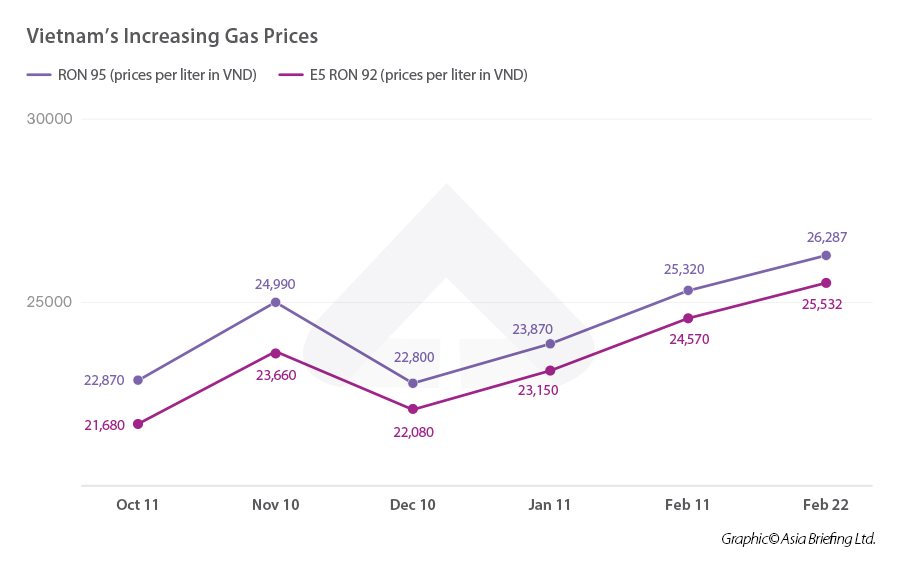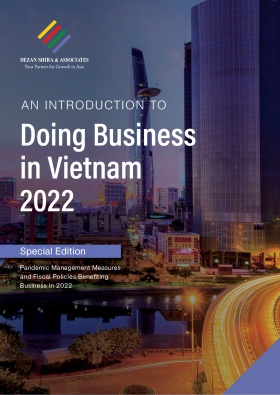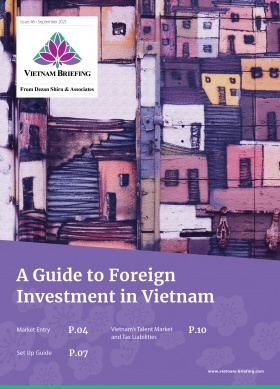Vietnam’s Fuel Price Hikes Affecting Businesses, Government Considers Tax Cuts
- Rising demand has pushed Vietnam’s fuel price to a historic high concerning businesses.
- Price hikes are fanning inflationary pressures and posing challenges for the country’s economic recovery.
- Increasing imports, tax reduction, and further support from the national reserves are some measures the government has targeted to alleviate the situation.
Since October 2021, Vietnam has witnessed a spike in demand for petroleum products along with an increase in fuel prices in line with global demand and price hikes.
More recently, according to oilprice, on February 22, the price of American light crude oil exceeded US$94.38 per barrel, an increase of US$3.31 or 3.63 percent, the highest since November 2014. Similarly, the price of Brent crude oil also increased since then and has now reached US$95.39 per barrel, up 1.98 percent or equivalent to US$1.85.
In Vietnam, as of February 22, the retail price of RON 95 gasoline has also climbed to an eight-year high of US$1.14 (VND 26,287) per liter. At the same time, the retail price of RON 92, reached US$1.11
As expected, in a recent increase, the government hiked fuel prices up by VND 1,000 (US$0.04) for each liter of gasoline and VND 750 (US$0.03) for each liter of oil.
It has been the fifth price increase since October 2021 and the fourth increase since the beginning of this year.
Several factors leading to scenario of price hikes and shortages
Vietnam’s gasoline and oil prices have been increasing sharply due to several reasons.
As Vietnam opens up along with other countries practicing a ‘live with the virus’ approach, many governments have lifted restrictions to reopen their economies and resume production, increasing fuel demand resulting in higher prices.
Secondly, because the Organization of Petroleum Exporting Countries (OPEC) still limits oil production instead of increasing output, supply is limited.
Third, political uncertainty and geopolitics occurring in some areas such as the Russia-Ukraine crisis have also indirectly pushed up prices.
The spike in Vietnam’s fuel prices was further accentuated by domestic gasoline shortages as the Nghi Son Oil Refinery, Vietnam’s largest refinery, cut production by 20 percent since January due to financial problems. While it has secured temporary investment, there are fears that it may have to shut down if the refiner fails to secure enough liquidity or loans to pay for Kuwaiti crude to feed its operation.
How are high fuel prices impacting the economy?
Nationwide, the higher fuel prices have businesses concerned as they want to balance price increases with keeping customers as Vietnam looks to bounce back from last year’s lockdowns.
Gasoline prices have a significant impact on both production and people’s daily lives, as well as on the competitiveness of enterprises. Thus, when gasoline prices increase, it will raise the cost of input materials both directly and indirectly.
Directly for people, businesses, and industries that consume petroleum products such as road transport, fishing, agricultural production, food processing, and indirectly for any other businesses that demand the transport of goods from the place of production to the place of consumption, affecting the price of consumer goods.
Higher fuel prices have posed a dilemma for many transport companies whether to continue or suspend their business. Continuing to operate will result in losses while suspending operations may result in a loss of revenue and competition as well as disruption to loans. While many want to increase fares this may lead to a decline in the number of passengers who already have low demand amid the pandemic.
The fuel price hikes have also already led to an increase in the prices of some products. Tires and lubricants, for example, have gone up by 20-30 percent. Some transport services have increased prices by 5-10 percent.
The retail industry has also been hit by price hikes. Fuel price increases have had knock-on effects as these businesses have to pay extra fees for delivery and input materials. Some food and beverage establishments have also raised their prices by 20-30 percent.
The logistic industry is facing pressure and has increased prices, while the manufacturing sector is also facing difficulties. Small traders in markets have also looked to increase prices to cut losses.
Further, when fuel prices continue to rise at such rates, the recent 2 percent cut in VAT, which is supposed to boost consumer spending and stimulate the economy, may have limited effect.
The high fuel prices have also raised concerns about rising inflation and its negative impacts on Vietnam’s overall GDP affecting the consumer price index and inflation.
According to Ngo Bich Lam, former head of the General Statistics Office (GSO), a 10 percent increase in fuel prices will lower GDP by around 0.5 percent and hike CPI by 0.36 percentage points.
Last week, HSBC also raised its inflation forecast for Vietnam from 2.7 percent to 3 percent this year after taking into account the higher energy prices. In the meantime, the Asian Development Bank (ADB) evaluated the figure at 3.8 percent.
However, this is still lower than the government’s target of 4 percent. As per government sources, the inflation rate is likely to stay under control through 2022.
Government assures fuel supply sufficient, though acknowledges short term shortages
While domestic fuel prices will likely remain high in the near term, the government has assured that long-term supply remains intact.
First, as Nghi Son Oil Refinery cut production by 20 percent, Binh Son Oil Refinery in Quang Ngai has recently raised its productivity since January to help alleviate demand
In addition, while the government insists all petroleum businesses have enough fuel, both Hanoi and Ho Chi Minh City have reported that they have sufficient fuel reserves for up to 30 days.
However, they have been reported shortages at fuel stations in some areas of Ho Chi Minh City and other southern localities. These are private enterprises that find trouble importing gasoline and oil from small and medium suppliers after Nghi Son Refinery reduced capacity.
Nevertheless, as per the Ministry of Industry and Trade (MoIT), this has affected only 2 percent of all 548 petrol stations in Ho Chi Minh City. Particularly, since the first half of February, the total volume of imported gasoline has risen from 500,000 cubic meters per month previously to 800,000 cubic meters.
Government measures
State-owned oil corporations have stepped up further imports to guarantee supply. Specifically, the Vietnam Oil Corporation (PVOil) has planned to import 26,000 cubic meters of petrol and 42,000 cubic meters of oil. Meanwhile, the Vietnam National Petroleum Group (Petrolimex) has also signed import contracts to ensure the supply of petroleum to the market.
The government is also set to auction 100 million liters of RON 92 gasoline at US$0.62 per liter from the national reserves this month to increase supply amid reports of shortages in some places.
To prevent goods hoarding and profiteering, the government has also carried out strict checks to strengthen preventive measures and strictly punish violators.
Vietnam’s Prime Minister has also requested the Ministry of Finance (MoF) to consider a reduction of environmental tax on fuel with a report before February 28. The proposal will then go to the National Assembly for approval. Taxes and fees account for around 42 percent of gasoline prices in Vietnam including special consumption tax, import tax, environmental tax, and value-added tax.
Takeaways
The government has laid out a plan to deal with the current shortages and price hikes. Additionally, as per the government, the current supply will meet market demand as the Nghi Son Refinery is expected to run at full capacity from mid-March.
However, fuel price hikes and supply are likely to be concerns in the medium term due to geopolitical tensions between Russia and Ukraine and the possible effects of Western sanctions. It will be a wait and watch scenario
Therefore, businesses should factor in and be prepared for additional price hikes resulting in increased prices of imported goods and domestic raw materials, while manufacturing businesses are likely to face additional challenges.
About Us
Vietnam Briefing is produced by Dezan Shira & Associates. The firm assists foreign investors throughout Asia from offices across the world, including in Hanoi, Ho Chi Minh City, and Da Nang. Readers may write to vietnam@dezshira.com for more support on doing business in Vietnam.
We also maintain offices or have alliance partners assisting foreign investors in Indonesia, India, Singapore, The Philippines, Malaysia, Thailand, Italy, Germany, and the United States, in addition to practices in Bangladesh and Russia.
- Previous Article Вопросы и ответы: ведение бизнеса во Вьетнаме – перспективы на 2022 год
- Next Article Vietnam Business Forum 2022: Restoring the Economy and Developing Supply Chains








